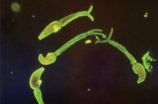(Press-News.org) Researchers from North Carolina State University and the University of Tennessee have found that environmental stressors – from the Trail of Tears to the Civil War – led to significant changes in the shape of skulls in the eastern and western bands of the Cherokee people. The findings highlight the role of environmental factors in shaping our physical characteristics.
"We wanted to look at these historically important events and further our understanding of the tangible human impacts they had on the Cherokee people," says Dr. Ann Ross, a professor of anthropology at NC State and co-author of a paper describing the work. "This work also adds to the body of literature on environmental effects on skull growth."
The researchers drew on historical data collected by Franz Boas in the late 19th century. Boas collected measurements of the length (front-to-back) and breadth of skulls for many Native American tribes, including hundreds of members of the eastern and western bands of Cherokee.
The researchers analyzed the data, looking only at adults and organizing the adults by year of birth, which ranged from 1783 to 1874. The year of birth, a critical piece of information, provided clues to stressors in an individual's life. For example, the western band of the Cherokee was subject to the Trail of Tears in 1838, intertribal warfare in the West, disease epidemics, and the U.S. Civil War from 1861 to 1865.
The researchers found that head length decreased over time in both bands, for males and females.
In the eastern band, there was a steady decline for males, but a sharp decline for females beginning in the late 1830s – coinciding with the Trail of Tears, when the eastern band fled into the Great Smoky Mountains to avoid forced evacuation to the West.
In the western band, males and females shared a similar pattern of decline: a sharp decline from the late 1820s to the 1850s, followed by a short increase, and then another sharp decline in the early 1860s with the onset of the Civil War.
"When times are tough, people have less access to adequate nutrition and are at greater risk of disease," Ross says. "This study demonstrates the impact that those difficult times had on the physical growth of the Cherokee people.
"The study also contributes to our understanding of how environmental stressors can influence skull measurements, which has value for helping us understand prehistoric cultures, historic populations, and the impact of environmental factors on the health of current populations in the developing world."
INFORMATION:
The paper, "Secular trends in Cherokee cranial morphology: Eastern vs Western bands," is published online in the Annals of Human Biology. Lead author of the paper is Rebecca Sutphin, a former graduate student at NC State. The paper was co-authored by Dr. Richard Jantz of the University of Tennessee.
Study: The trials of the Cherokee were reflected in their skulls
2014-04-16
ELSE PRESS RELEASES FROM THIS DATE:
Progress in understanding immune response in severe schistosomiasis
2014-04-16
BOSTON (April 16, 2014) —Researchers at the Sackler School of Graduate Biomedical Sciences at Tufts and Tufts University School of Medicine (TUSM) have uncovered a mechanism that may help explain the severe forms of schistosomiasis, or snail fever, which is caused by schistosome worms and is one of the most prevalent parasitic diseases in the world. The study in mice, published online in The Journal of Immunology, may also offer targets for intervention and amelioration of the disease.
Schistosomiasis makes some people very sick whereas others tolerate it relatively well, ...
Floating nuclear plants could ride out tsunamis
2014-04-16
CAMBRIDGE, Mass-- When an earthquake and tsunami struck the Fukushima Daiichi nuclear plant complex in 2011, neither the quake nor the inundation caused the ensuing contamination. Rather, it was the aftereffects — specifically, the lack of cooling for the reactor cores, due to a shutdown of all power at the station — that caused most of the harm.
A new design for nuclear plants built on floating platforms, modeled after those used for offshore oil drilling, could help avoid such consequences in the future. Such floating plants would be designed to be automatically cooled ...
Bristol academics invited to speak at major 5G summit
2014-04-16
For more than 20 years academics from the University of Bristol have played a key role in the development of wireless communications. In particular, they have contributed to the development of today's Wi-Fi and cellular standards. Two Bristol engineers, who are leaders in this field, have been invited to a meeting of technology leaders to discuss the future of wireless communications. The first "Brooklyn 5G Summit" will be held next week [April 23-25] in New York, USA.
Andrew Nix, Professor of Wireless Communication Systems and Mark Beach, Professor of Radio Systems ...
Researchers question emergency water treatment guidelines
2014-04-16
The Environmental Protection Agency's (EPA's) recommendations for treating water after a natural disaster or other emergencies call for more chlorine bleach than is necessary to kill disease-causing pathogens and are often impractical to carry out, a new study has found. The authors of the report, which appears in the ACS journal Environmental Science & Technology, suggest that the agency review and revise its guidelines.
Daniele Lantagne, who was at the Centers for Disease Control and Prevention (CDC) at the time of the study and is now at Tufts University, and colleagues ...
Relieving electric vehicle range anxiety with improved batteries
2014-04-16
RICHLAND, Wash. – Electric vehicles could travel farther and more renewable energy could be stored with lithium-sulfur batteries that use a unique powdery nanomaterial.
Researchers added the powder, a kind of nanomaterial called a metal organic framework, to the battery's cathode to capture problematic polysulfides that usually cause lithium-sulfur batteries to fail after a few charges. A paper describing the material and its performance was published online April 4 in the American Chemical Society journal Nano Letters.
"Lithium-sulfur batteries have the potential to ...
Breakthrough points to new drugs from nature
2014-04-16
Researchers at Griffith University's Eskitis Institute have developed a new technique for discovering natural compounds which could form the basis of novel therapeutic drugs.
The corresponding author, Professor Ronald Quinn AM said testing the new process on a marine sponge had delivered not only confirmation that the system is effective, but also a potential lead in the fight against Parkinson's disease.
"We have found a new screening method which allows us to identify novel molecules drawn from nature to test for biological activity," Professor Quinn said.
"As it ...
Global scientific team 'visualizes' a new crystallization process
2014-04-16
VIDEO:
This is a high speed video of the crystal ribbons forming as the solution is spread using a squeegee like technique.
Click here for more information.
Sometimes engineers invent something before they fully comprehend why it works. To understand the "why," they must often create new tools and techniques in a virtuous cycle that improves the original invention while also advancing basic scientific knowledge.
Such was the case about two years ago, when Stanford engineers ...
Researchers propose network-based evaluation tool to assess relief operations feasibility
2014-04-16
The United Nations Office for Disaster Risk Reduction reported that disasters have affected around 2.9 billion people worldwide from 2000-2012— killing more than a million, and damaging around 1.7 trillion US dollars in estimates. Moreover, natural disasters and their damages have been documented to occur with increasing intensity. Given the staggering numbers, effective disaster preparedness and relief response plans is compelling, especially considering the fact that natural disasters are usually unpredictable and damage cannot be avoided.
Implementing a speedy and ...
Medieval slave trade routes in Eastern Europe extended from Finland and the Baltic Countries to Asia
2014-04-16
The routes of slave trade in Eastern Europe in the medieval and pre-modern period extended all the way to the Caspian Sea and Central Asia. A recent study completed at the University of Eastern Finland suggests that persons captured during raids into areas which today constitute parts of Finland, the Russian Karelia and the Baltic Countries ended up being sold on these remote trade routes. There was a particular demand for blonde girls and boys who were seen as exotic luxury items, and it was financially beneficial to transport them to the far-away markets. The study by ...
Study provides new insight into how toddlers learn verbs
2014-04-16
Parents can help toddlers' language skills by showing them a variety of examples of different actions, according to new research from the University of Liverpool.
Previous research has shown that verbs pose particular difficulties to toddlers as they refer to actions rather than objects, and actions are often different each time a child sees them.
To find out more about this area of child language, University psychologists asked a group of toddlers to watch one of two short videos. They then examined whether watching a cartoon star repeat the same action, compared ...



